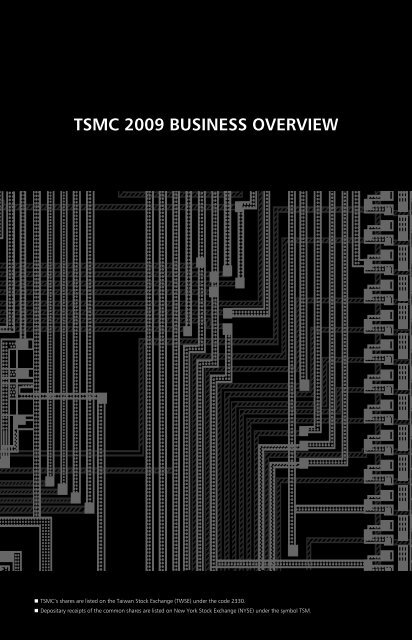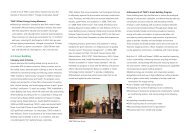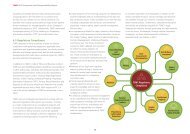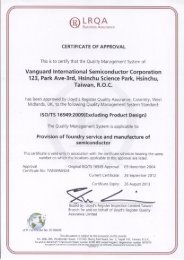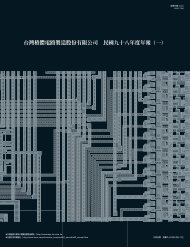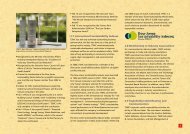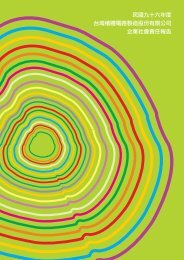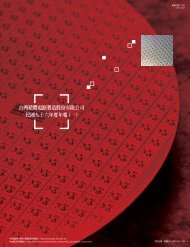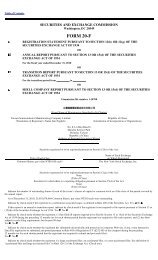2009 Business Overview - TSMC
2009 Business Overview - TSMC
2009 Business Overview - TSMC
You also want an ePaper? Increase the reach of your titles
YUMPU automatically turns print PDFs into web optimized ePapers that Google loves.
■ <strong>TSMC</strong>’s shares are listed on the Taiwan Stock Exchange (TWSE) under the code 2330.■ Depositary receipts of the common shares are listed on New York Stock Exchange (NYSE) under the symbol TSM.
LETTER TO SHAREHOLDERS<strong>TSMC</strong> <strong>2009</strong> BUSINESS OVERVIEW02
1. LETTER TO SHAREHOLDERSDear Shareholders,At the start of <strong>2009</strong>, we managed the sharp business downturn that gripped the global economy, and then enhanced ourcore strengths by committing more resources into technology innovations, recruiting talents, and expanding our productioncapacity to meet customers’ needs. Now the global economy is on its gradual recovery course and the outlook forsemiconductor industry in 2010 appears robust, <strong>TSMC</strong> is in a stronger position to compete.The steep downturn in the global semiconductor industry in 4Q’08 and 1Q’09 was followed by a recovery the rate of whichwas unprecedented in the history of the foundry segment. At the start of the slump, management moved with speed tominimize the negative financial impact. Later on, when demand fast recovered, we demonstrated remarkable agility inquickly ramping up production capacity and capturing the pursuant recovery. In the process, the Company lowered itsbreakeven utilization rate and maintained profitability throughout the downturn.<strong>TSMC</strong> is now headed forward on a course to capture greater share within the dedicated foundry segment throughcontinued development of the leading-edge process technology nodes, while aggressively broadening the Company’sbusiness portfolio into derivative technologies across all legacy technology nodes.Financial ResultsTotal consolidated revenue for <strong>2009</strong> was NT$295.74 billion, an 11.2 percent decrease compared with NT$333.16 billion in2008. Net income decreased 10.7 percent to NT$89.22 billion from NT$99.93 billion, while diluted earnings per sharedecreased 9.6 percent to NT$3.44 compared with NT$3.81 a year earlier.In US dollars, <strong>TSMC</strong>’s <strong>2009</strong> revenue was US$9 billion and net income was US$2.71 billion, compared with revenue ofUS$10.61 billion and net income of US$3.18 billion in 2008.Among other highlights in <strong>2009</strong>, <strong>TSMC</strong> achieved:● Gross profit margin of 43.7 percent; and● Operating profit margin of 31.1 percent.During the year, <strong>TSMC</strong> shipped 7.74 million eight-inch equivalent wafers, representing about 7.6 percent of global IC wafershipments, compared with 7.4 percent a year ago.Technology, Capacity and CustomersWhile the semiconductor industry will grow strongly in 2010, it is likely to grow at an average mid-single-digit rate in the2011-2016 period. On the one hand, it is vital for <strong>TSMC</strong> to maintain and augment its leadership position in the foundrysegment by intensifying the pace of semiconductor manufacturing innovation and by expanding its own capabilities toenlarge market opportunities. On the other hand, <strong>TSMC</strong> also embarked on a vigorous program to expand the base of ourbusiness to encompass adjacent opportunities that fit our strengths in engineering capabilities and the ability to managemassive scale operations. In addition, to start the development of new businesses, Dr. Rick Tsai has been assigned to devotehis full time to this task as President of New <strong>Business</strong>es, starting June 12, <strong>2009</strong>. Meanwhile, I resumed CEO responsibility.03
<strong>TSMC</strong> <strong>2009</strong> BUSINESS OVERVIEWLETTER TO SHAREHOLDERSToday, <strong>TSMC</strong> serves more than four hundred customers and manufactures more than seven thousand products for them ina year. We are proud to count every major player in each of the semiconductor logic applications as our customers. Webuild customer partnership with our technology leadership and manufacturing excellence, both of which are executed underan overall corporate culture centered on servicing customers’ needs. In order to better focus on strengthening our customerpartnership, the Company has further re-organized to form an Operations Organization to facilitate manufacturingoperations excellence, and a <strong>Business</strong> Development Organization to coordinate customer partnership.We continue to focus resources on strengthening our leading position in our core business of outsourced manufacturing foradvanced IC producers. The Company has invested US$2.7 billion in <strong>2009</strong> to further expand its advanced technologycapacity for 12-inch wafer fabs, with 85% of the spending on capacities for 40/45nm and 65nm technologies, which areexpected to contribute over 40% of our wafer revenue in 2010.Technology Innovation<strong>TSMC</strong> continues to be a technology leader in the semiconductor industry with the development of the most advanced logictechnologies both with conventional (poly SiON) as well as high-K/metal gate (HKMG) stacks at the 28-nanometer (28nm)node. Early in <strong>2009</strong>, we became the first foundry to achieve 28nm functional 64Mb SRAM yield on our high performance(28HP) as well as low leakage (28HPL) HKMG technologies. With our 28nm shuttle program, functional silicon was deliveredin both conventional and HKMG platforms. We are well on track for qualification and risk production in 2010 for our 28nmtechnology offerings.Corporate DevelopmentsIn November, <strong>TSMC</strong> agreed to a settlement with SMIC. The litigation and settlement have resulted in the full protection of<strong>TSMC</strong>’s trade secrets in the possession of SMIC. Under the new settlement agreement and the related stipulated judgment,SMIC has agreed to make cash payments totaling US$200 million and other valuable considerations to <strong>TSMC</strong>. Both partiesalso agreed to terminate the patent cross-licensing agreement signed in 2005.<strong>TSMC</strong> also invested US$193 million for a 20% equity stake in Motech, the largest solar cell manufacturer in Taiwan. TheMotech investment allows <strong>TSMC</strong> to accelerate our time to market, to better evaluate opportunities along the solar valuechain, and to further formulate our overall solar strategy.04
Honors and Awards<strong>TSMC</strong> continued to garner recognition and awards from around the world as a corporate role model. <strong>TSMC</strong>’s disclosure andtransparency and its focus on shareholder value have won top honors from AsiaMoney, The Asset Magazine, CorporateGovernance Asia, FinanceAsia, GlobalView Magazine, and the IR Magazine in the areas of Corporate Governance,Management, Investor Relations, and Corporate Social Responsibilities. Both the Wall Street Journal and CommonWealthMagazine voted <strong>TSMC</strong> as Taiwan’s Overall Most Admired Company. As a leader in good corporate citizenship, <strong>TSMC</strong> isincluded in the Dow Jones Sustainability Index.OutlookImprovement in the global macroeconomic environment is likely to continue into 2011. With the fast growing emergingeconomies consuming an increasing amount of semiconductors, we expect the industry to grow at a rate in the teens andthe foundry segment to outpace the overall semiconductor industry at a growth rate exceeding 20 percent in 2010. <strong>TSMC</strong>has aggressive plans to gain market share in this upturn by further strengthening our technology leadership and byproviding sufficient capacity to meet the strong demand from our customers. Management believes <strong>TSMC</strong> can surpass boththe Company’s 2008 revenue record and its 2006 net income record, after adjusting for employee profit sharing, in 2010.Morris ChangChairman and Chief Executive Officer05
INTRODUCTION AND MARKET OVERVIEW<strong>TSMC</strong> <strong>2009</strong> BUSINESS OVERVIEW06
2. INTRODUCTIONAND MARKET OVERVIEWAn Introduction to <strong>TSMC</strong><strong>TSMC</strong> is the world’s largest pure-play semiconductor foundry. Founded on February 21, 1987 and headquartered inHsinchu, Taiwan, <strong>TSMC</strong> pioneered the business model of focusing solely on manufacturing customers’ semiconductordesigns. As a pure-play semiconductor foundry, the Company does not design, manufacture, or market semiconductorproducts under its own brand name, ensuring that <strong>TSMC</strong> does not compete directly with its customers.With a diverse global customer base, <strong>TSMC</strong>-manufactured microchips are used in a broad variety of applications that covervarious segments of the computer, communications and consumer electronics markets.Total capacity of the manufacturing facilities managed by <strong>TSMC</strong>, including subsidiaries and joint ventures, totaled 9.96million 8-inch equivalent wafers in <strong>2009</strong>. In Taiwan, <strong>TSMC</strong> operates two advanced 12-inch wafer fabs, four 8-inch waferfabs, and one 6-inch wafer fab. <strong>TSMC</strong> also manages two 8-inch fabs at wholly owned subsidiaries: WaferTech in the UnitedStates and <strong>TSMC</strong> China Company Limited. In addition, <strong>TSMC</strong> obtains 8-inch wafer capacity from other companies in whichthe Company has an equity interest.<strong>TSMC</strong> provides customer service through its account management and engineering services offices in North America,Europe, Japan, China, South Korea, and India. The Company employed more than 24,000 people worldwide as of the endof <strong>2009</strong>.<strong>TSMC</strong> continued to lead the foundry segment of the semiconductor industry in advanced process technologies. Already thefirst foundry to provide 65nm and 40nm production capacity, <strong>TSMC</strong> also announced it will deliver 28nm as a full nodetechnology, and, in <strong>2009</strong>, reported the addition of 28HPL (High-k metal gate with low power) to enrich its 28nm offering.In addition to general-purpose logic process technology, <strong>TSMC</strong> supports the wide-ranging needs of its customers withembedded non-volatile memory, embedded DRAM, mixed signal/RF, high voltage, CMOS image sensor, color filter, MEMS,and silicon germanium technologies. In December <strong>2009</strong>, <strong>TSMC</strong> also announced the automotive industry’s first processqualification specification and service package for automotive-grade semiconductor manufacturing in the China market.<strong>TSMC</strong> Fab 10 in Shanghai, along with multiple fabs in Taiwan, is capable of supporting the automotive service package.In addition, in order to better manage <strong>TSMC</strong>’s long-term strategic growth opportunities, <strong>TSMC</strong> has decided to invest in LEDlighting and solar energy related-industries. With differentiated technology offerings and with unique value proposition tocustomers, <strong>TSMC</strong> will pursue new opportunities in these fields.The Company is listed on the Taiwan Stock Exchange (TWSE) under ticker number 2330, and its American Depositary Sharestrade on the New York Stock Exchange (NYSE) under the symbol “TSM”.07
INTRODUCTION AND MARKET OVERVIEW<strong>TSMC</strong> <strong>2009</strong> BUSINESS OVERVIEWINTRODUCTION AND MARKET OVERVIEWMarket and <strong>Business</strong> Summary<strong>TSMC</strong> AchievementsIn <strong>2009</strong>, <strong>TSMC</strong> maintained its leading position in the pure-play foundry segment of the global semiconductor industry, withan estimated market segment share of 48%. <strong>TSMC</strong> achieved this result amid fierce competition from both establishedplayers and relatively new entrants to the business.Leadership in advanced process technologies is a key factor in <strong>TSMC</strong>’s strong market position. In <strong>2009</strong>, 67% of <strong>TSMC</strong>’swafer revenue came from manufacturing processes with geometries of 0.13μm and below. A critical milestone was reachedin September <strong>2009</strong>, when <strong>TSMC</strong> shipped its one-millionth 65nm 12-inch wafer. Moreover, <strong>TSMC</strong> also achieved volumeproduction of the 45/40nm process as well as development of the leading-edge 28nm process, both foundry firsts. As of thefourth quarter of <strong>2009</strong>, 39% of <strong>TSMC</strong>’s wafer revenue came from 65nm processes and below.In addition to advanced technologies, <strong>TSMC</strong> also offers innovative services in line with its unwavering focus on customerpartnership. Among the many innovative services unveiled in <strong>2009</strong> was automotive process qualification specification andautomotive service package, tapping the growth momentum of automotive electronics. <strong>TSMC</strong> also launched foundry’s firstintegrated sign-off flow, mixed signal/radio frequency (RF) reference design kit and interoperable process design kit, whichenriched the Open Innovation Platform TM to facilitate timely innovation among the semiconductor design community.<strong>TSMC</strong> continued to advance the semiconductor roadmap in <strong>2009</strong>. Examples of technologies the Company developed orrolled out include:● 28nm low power technology with functional static random access memory (SRAM)● 40nm technology for low power and radio frequency (RF)● 55nm low power technology● 65nm multi-time programmable non-volatile memory technology● 0.11μm hybrid general performance technology● 0.11μm high voltage process for small panel single chip drivers● 0.13μm slim platform for analog and power management System-on-Chip (SoC) applications● 0.15μm high voltage process for large panel source driversIn addition, <strong>TSMC</strong> further strengthened its comprehensive development of specialty technologies in <strong>2009</strong>, including90/65nm embedded flash, 90/65nm CMOS image sensor and 0.13μm analog technologies. In <strong>2009</strong>, <strong>TSMC</strong> also revealedfoundry-first 3D Micro-Electro-Mechanical Systems (MEMS) platform for the integration of CMOS and motion sensors. Thesespecialty technologies are key differentiators from our competitors and provide customers more value.Market <strong>Overview</strong>It is estimated that the semiconductor market in <strong>2009</strong> reached US$226 billion in revenue, a 9% decrease compared to 2008.According to IC Insights, total foundry, a manufacturing sub-segment of the semiconductor industry, generated totalrevenues of US$22 billion in <strong>2009</strong>, -11% year-on-year. Revenues from pure-play foundries such as <strong>TSMC</strong> reached US$19billion, or 8% of total semiconductor industry revenue, and <strong>TSMC</strong>’s total revenue was US$9 billion.Industry Outlook, Opportunities and ThreatsIndustry Demand and Supply Outlook<strong>2009</strong> was a challenging year for the semiconductor industry, which experienced a decline of 9% year-over-year (YoY). Afterthe sharp market decline in the final quarter of 2008, foundry sales bottomed out in the first quarter of <strong>2009</strong>. Driven bybetter-than-expected demand and supply chain inventory replenishment, foundry sales recovered significantly throughoutthe rest of <strong>2009</strong>. According to IC Insights, pure-play foundry sales declined by 10% in <strong>2009</strong> compared to 2008.IC Insights forecasts pure-play foundry sales to grow at 24% YoY in 2010. As for the longer term, with improving globaleconomic outlook, increasing semiconductor content in electronics devices and the increasing IDM outsourcing, pure-playfoundry sales are expected to display an 14% compound annual growth rate (CAGR) from <strong>2009</strong> through 2014, higher thanthe 11% CAGR for total IC industry.08
COLLABORATE FOR SUCCESS<strong>TSMC</strong> <strong>2009</strong> BUSINESS OVERVIEW10
3. COLLABORATE FOR SUCCESSChairman Dr. Morris Chang’s Keynote Speech at the 2010 <strong>TSMC</strong> North American Technology SymposiumThe following is a summary of <strong>TSMC</strong> Chairman and CEO Dr. Morris Chang’s Keynote Speech at the 2010 <strong>TSMC</strong> NorthAmerican Technology Symposium on April 13, which addresses the changing environment of the semiconductor industryand the challenges ahead, as well as <strong>TSMC</strong>’s commitment to maintaining its technology and capacity leadership andcollaboration with customers to overcome these challenges.I would like to cover three subjects: the near term and the mid to long-term outlook of the semiconductor industry and how<strong>TSMC</strong> is positioned in this environment, the challenges that <strong>TSMC</strong> and our customers face, and finally, the necessity ofcollaboration to respond to the challenges that we will face.Semiconductor Market OutlookMy first topic is the near term and mid- to long-term outlook of the semiconductor market. <strong>Business</strong> is very good right nowand this year we are looking at very strong growth in the semiconductor market. We estimate that the market will grow 22percent this year, and the semiconductor market will reach US$276 billion. We also expect next year to be very good withgrowth of seven percent.In the mid to long term we see several factors that tend to slow worldwide semiconductor industry growth. First, it appearsthat the semiconductor content in electronics is rising very slowly and is now in the upper part of the S-curve. Another factorthat seems to be slowing semiconductor growth is that the average price of semiconductors continues to decline. Assemiconductor applications migrate from business applications to consumer applications, the price decline actually goes alittle faster. Also, as the applications go from developed countries to developing countries, the shift of the market venuetends to accelerate price decline also.Another factor is that there are some innovative components other than semiconductors that are emerging, such as touchscreen display, that tend to take up value and also tends to lessen the semiconductor content in electronics. And then aneven bigger factor is that Moore’s Law is slowing down.All those factors lead us to predict that semiconductor market growth in the 2011 to 2014 period will be around 4.2percent per year, and we see that the growth for fabless companies will be faster–around 7.2 percent.<strong>TSMC</strong>’s PositionNow I would like to talk about how <strong>TSMC</strong> is positioned in this environment. We know that what we can provide ourcustomers is really two things, technology and capacity. Those are the two things that we must provide to do our job, andwe commit ourselves to providing those two things to our customers well in the next few yearsOn technology, we have almost tripled our R&D force in the last five years and R&D expenses have more than doubled in thesame period.Moore’s Law, as I said, will slow down, but certainly for the next few generations it is still going to move forward.Twenty-eight nanometer, of course, is imminent. Twenty nanometer is going to happen. Fourteen nanometer, I think willmost probably happen. Even though the realization of 10 nanometer is going to be beyond my career, but I think in mycareer I will still do everything to make even 10 nanometer happen. So the next few generations are still very well withinreach.In terms of capacity, last year we increased our capital spending to US$2.7 billion, and this year we are going to have capitalspending of US$4.8 billion. In terms of employees, we went from 20,000 employees at our lowest point last year to about25,000 today, and we expect to be at about 29,000 at the end of the year. We believe that we will have by far the largesteffective capacity at any node of technology, and we intend to maintain the lead.11
If you extrapolate along the IBS line, there are only three at the 22-nanometer generation. If you extrapolate beyond that, Ithink you’ll get to only one company when you reach the 14-nanometer or 10 nanometer generations. But if anybody willbe there, <strong>TSMC</strong> will be.I think that as Moore’s Law becomes more difficult and the path becomes narrower, we’ve got to start joining more tightlywith our customers, and that’s collaboration.Collaborate for SuccessWe have always advocated collaboration, but the kind of collaboration that we advocate now is even more than the kind ofcollaboration that we advocated as late as four years ago. Four years ago I gave a talk saying “let us collaborate in as early inthe design phase as possible”. Now I’m advocating that we collaborate even before the design starts. The difference isbecause there are trade-offs to make, and we should make them together with our customers.The trade-offs are between power and performance. I think increasingly customers will not need performance improvement,but power improvement, so the trade-off of speed for leakage is a very, very important one, and it is something that thedesigner and the technologist should make together.Then there is the trade-off of transistor performance and design architecture, the co-optimization. We don’t really need veryfast transistors in every functional block. We can have just “good enough” transistors in some functional blocks, and achieveoverall cost and power reduction. At the system level the designer and the technologist can also start to includecomponents, resistors, capacitors in the package. That collaboration also needs to take place before the design even starts.So I believe that we can be far more effective in collaboration than we can by just each minding his own business, doing hisown job. <strong>TSMC</strong> is committed to being a technology and capacity leader, providing customers with the technology they wantand the capacity they need. Our challenges can be overcome with closer collaboration. Let us collaborate to win together.Thank you very much.13
CORPORATE SOCIAL RESPONSIBILITY<strong>TSMC</strong> <strong>2009</strong> BUSINESS OVERVIEW14
4. CORPORATE SOCIAL RESPONSIBILITY<strong>TSMC</strong>’s core values of Integrity, Commitment, Innovation, and Customer Partnership extend to every facet of its business.<strong>TSMC</strong> believes that a corporation’s most important responsibility to society is to help bring about healthy and positivechanges. To fulfill this responsibility:1) We are honest to our shareholders, to the public, and to our tens of thousands of employees.2) We respect the rule of law, and we do not engage in illegal activity.3) We abhor cronyism. We do not seek favoritism from the government or any government official, and we do not bribe.4) We practice good corporate governance.5) We do not engage in politics.6) We aim to provide not just job opportunities, but well-paying job opportunities in a good work environment.7) We emphasize protection of the environment and climate.8) We practice unceasing innovation.9) We invest in LED lighting and solar energy to directly contribute to a greener world through innovation.10) Within our corporate means, we make contributions to cultural and educational and community activities.Environmental, Safety and Health (ESH) Management<strong>TSMC</strong> believes its environmental, safety and health practices should not only comply with legal requirements, but alsomeasure up to recognized international practices. The Company aims to prevent pollution, efficiently use all resources,prevent accidents, improve employee safety and health, protect property, and establish a work environment that promotesthe well-being of our employees and of the communities in which we operate.Environmental ProtectionGreenhouse Gas (GHG) Emission Reduction<strong>TSMC</strong> takes measures to reduce its emission of greenhouse gases. <strong>TSMC</strong> has endorsed a memorandum of understandingbetween the Taiwan Semiconductor Industry Association, the ROC Environmental Protection Administration, and the WorldSemiconductor Council, whereby <strong>TSMC</strong> is committed to reducing PFC emissions to 10% below the average of 1997 and1999 by 2010. This emissions target remains fixed as <strong>TSMC</strong> continues to grow and expand its manufacturing facilities.<strong>TSMC</strong> not only actively inventories and reduces its own greenhouse gas emissions, but also requires suppliers to inventorygreenhouse gas emissions. Under this plan, <strong>TSMC</strong> as well as 36 factories at 20 partner companies registered and disclosedgreenhouse gas emissions under the guidance of the Taiwan Green Productivity Foundation.Water ConservationTo make the most effective use of Taiwan’s limited water resources, all <strong>TSMC</strong> fabs make efforts to increase waterreclamation rates by adjusting the water usage of manufacturing equipment and improving wastewater reclamationsystems. New fabs are able to reclaim more than 85% of process water, meeting or exceeding the standards of the SciencePark Administration and outperforming most semiconductor fabs around the world.Waste Management and RecyclingTo meet the goal of sustainable resource utilization, <strong>TSMC</strong>’s first priority is to reduce process waste before consideringrecycling or disposal. Waste recycling achieved the goal of 90% in <strong>2009</strong>, and the Company’s landfill rate has been reducedto less than 1%.15
<strong>TSMC</strong> <strong>2009</strong> BUSINESS OVERVIEWGreen Building<strong>TSMC</strong> initiated a “green factory” program in 2006 to improve environmental performance and health. The program coversdesign and construction of new fabs, enhancement of existing fabs, internal training, and encouraging partners to gain“green building” certification. To reach our targets, <strong>TSMC</strong> established a Green Building Task Force, which will certify newfabs and existing office buildings according to the U.S. Leadership in Energy and Environmental Design (LEED) standard andTaiwan’s Ecology, Energy Saving, Waste Reduction, Health (EEWH) standard. In 2008 and <strong>2009</strong> respectively, <strong>TSMC</strong>’snewly-constructed Fab14 Phase 3 and Fab12 Phase 4 won EEWH diamond level and LEED gold level certification.CORPORATE SOCIAL RESPONSIBILITYIC Product Category Rule ProjectIn <strong>2009</strong>, <strong>TSMC</strong> collaborated with its assembly subcontractor, Advanced Semiconductor Engineering Group (ASE) tocomplete the world’s first Integrated Circuit Product Category Rule (IC PCR). This IC PCR follows ISO 14025 standards, andaddresses the unique nature of semiconductor manufacturing. It was compiled based on input from major semiconductorcompanies around the world. The content of the IC PCR covers energy and water consumption, pollutant production, wasteproduction, air pollution, carbon footprint, and other factors. It can act as a reference for global semiconductor companieswhen completing an Environmental Product Declaration Type III (EPD). Meanwhile, <strong>TSMC</strong> and ASE followed this IC PCR tocomplete an EPD Type III for integrated circuits and obtained a Carbon Footprint Certification from the Taiwan Electrical andElectronic Manufacturers’ Association (TEEMA), taking a major step forward in manufacturing low-carbon products.Safety and Health Management<strong>TSMC</strong>’s safety and health management is built on the framework of the OHSAS 18001 system, and adheres to themanagement principle of “Plan, Do, Check, Act” to prevent accidents and protect employee safety and health as well asCompany assets. In <strong>2009</strong>, <strong>TSMC</strong> fabs in Taiwan have simultaneously received OHSAS 18001 certification and TOSHMScertification for Taiwan occupational safety and health management system.Besides accident prevention, <strong>TSMC</strong> has established emergency response procedures to protect the lives of employees andcontractors if disasters should occur, as well as to minimize the negative impact on society and the environment. <strong>TSMC</strong>communicates to suppliers to reduce potential risks in the operation of production equipment and follows safety controlprocedures when installing production equipment. The Company places stringent controls on high-risk operations and alsoevaluates the seismic tolerance of facilities and equipment to reduce the risk of earthquake damage. In health management,<strong>TSMC</strong> maintains regular wellness and professional health programs, such as establishing kitchen GHP (Good Health Practice),metal health appraisal and control and specific group health examination alignment. <strong>TSMC</strong> also maintains Company-levelprevention committees when infectious diseases such as H1N1 influenza, Severe Acute Respiratory Syndrome (SARS) orAvian Influenza pose a potential risk to the Company.<strong>TSMC</strong> Education and Culture FoundationThe <strong>TSMC</strong> Education and Culture Foundation, established in 1988 to coordinate the Company’s sponsorship as part of itsefforts in corporate social responsibility, continues to devote its resources towards education, sponsorships of art and cultureevents, community building, and the employee volunteer program.Commitment to EducationTalents are essential to the development of the economy. As a leader of Taiwan’s knowledge-based industry, <strong>TSMC</strong> regardscultivating talented people for society as a major responsibility. In <strong>2009</strong>, Tzi-Shueh Hall of the Chemistry Department inNational Taiwan University, donated by the <strong>TSMC</strong> Foundation, was inaugurated. The new research building will provide astrong base for scientific research and development in Taiwan. In the meantime, <strong>TSMC</strong> continues to devote resources tovarious programs targeting a whole range of education at different age levels, including the <strong>TSMC</strong> Youth CalligraphyContest, the <strong>TSMC</strong> Youth Literature Contest, and the Wu Chien-Shiung and the Wu Ta-You Science Camps.16
Contributions to CommunitiesThe Foundation continues to promote arts and cultural activities in <strong>TSMC</strong> site communities of Hsinchu and Tainan. Everyyear the Company organizes the <strong>TSMC</strong> Hsin-Chu Art Festival to bring the culture activities to these high-tech cities andencourage a greater art appreciation in the communities. Last year, the <strong>TSMC</strong> Foundation chose “Find a New World” as thetheme of Hsin-Chu Art Festival to arrange a series of educational and cultural programs.Sponsorship of the ArtsTo promote the Chinese classics and culture, the <strong>TSMC</strong> Foundation continued to support the broadcasting program“Analects in Hsin’s View”. <strong>TSMC</strong> also continued its support of the Taiwan Literature Camp, which provides workshop andlectures by distinguished authors to people interested in literature.Employee Volunteer ProgramIn addition to sponsoring education and art programs, the <strong>TSMC</strong> Foundation encourages <strong>TSMC</strong> employees to devotethemselves to promote education, bridge the resources gap, and pursue energy conservation. The newly formedEnergy-Saving Volunteer team provided two Hsin-chu high schools with the means to evaluate the safety and efficiency intheir power usage with counseling in energy-saving programs. In addition to the Energy-saving Volunteer team, <strong>TSMC</strong>employees have also served as guides to introduce the electronic industry at the National Science Museums duringweekends, and read books to the elementary students in remote townships on weekdays. Several hundred of <strong>TSMC</strong>“Museum Touring” and “Book Reading” volunteers have already served for six years. Since 2003, there are total 3,000 <strong>TSMC</strong>employees to devote themselves to the society.Typhoon Morakot Disaster Relief ProjectTyphoon Morakot struck south Taiwan, causing Taiwan’s most severe flooding in 50 years. <strong>TSMC</strong> and all its employees aredeeply saddened by the suffering caused by this typhoon, and we have assembled a “Typhoon Morakot Project Team” andhave decided to donate NT$200 million to provide some small measure of relief to the people and places affected by thisdisaster.1) Distributed NT$50 million in relief funds to more than 1,000 employees affected by the floods. As <strong>TSMC</strong> employees comefrom all over Taiwan, many colleagues and their families live in areas severely affected by this disaster. We therefore askedmanagers at all levels to inquire whether their staff was affected by the flooding and whether they need assistance.2) Provided NT$50 million to assist in the repair and restoration of damaged middle and elementary schools around theSouth Taiwan Science Park to reopen before the beginning of the school year.3) Pledged NT$100 million to assist in the government’s overall relief efforts, with guidance from the cabinet’s MorakotPost-Disaster Reconstruction Council. <strong>TSMC</strong> will focus on Aborigine villages in Alishan Township.17
CORPORATE GOVERNANCECORPORATE GOVERNANCE<strong>TSMC</strong> <strong>2009</strong> BUSINESS OVERVIEW18
5. CORPORATE GOVERNANCE<strong>TSMC</strong> advocates and acts upon the principles of operational transparency and respect for shareholder rights. We believe thatthe basis for successful corporate governance is a sound and effective Board of Directors. In line with this principle, <strong>TSMC</strong>’sBoard of Directors established an Audit Committee in 2002 and a Compensation Committee in 2003. <strong>TSMC</strong>’s corporategovernance won international recognition in <strong>2009</strong>: Corporate Governance Asia honored <strong>TSMC</strong> with its “CorporateGovernance Asia Recognition in Taiwan”. FinanceAsia Magazine ranked <strong>TSMC</strong>’s corporate governance as the best among allcompanies in Taiwan with its “Best at Corporate Governance” for the Taiwan region.Board of Directors<strong>TSMC</strong>’s Board of Directors consists of seven (Note) distinguished members with a great breadth of experience as world-classbusiness leaders or scholars. Three of the seven members are independent directors: former British TelecommunicationsChief Executive Officer, Sir Peter Bonfield; former Acer Group Chairman, Mr. Stan Shih; and former Texas Instrument Inc.Chairman of the Board, Mr. Thomas J. Engibous. Under the leadership of Chairman Morris Chang, <strong>TSMC</strong>’s Board ofDirectors takes a serious and forthright approach to its duties and is a serious, competent and independent Board.In the spirit of Chairman Chang’s approach to corporate governance, a board of directors’ primary duty is to supervise. TheBoard should supervise the Company’s: compliance with relevant laws and regulations; financial transparency; timelydisclosure of material information, and maintaining of highest integrity within the Company. <strong>TSMC</strong>’s Board of Directorsstrives to perform through the Audit Committee and the Compensation Committee, the hiring of a financial expert for theAudit Committee, coordination with the Internal Audit department, and through the ombudsman reporting system.The second duty of the board of directors is to provide guidance to the management team of the Company. Quarterly,<strong>TSMC</strong>’s management reports to the <strong>TSMC</strong> Board on a variety of subjects. The management also reviews the Company’sbusiness strategies with the Board. Furthermore, the management often reviews with and updates <strong>TSMC</strong>’s Board on theprogress of the strategies, obtaining Board guidance as appropriate.The third duty of the Board of Directors is to evaluate the management’s performance and to dismiss officers of theCompany when necessary. <strong>TSMC</strong>’s management has maintained a healthy and functional communication with <strong>TSMC</strong> Boardof Directors, has been devoted in executing guidance of <strong>TSMC</strong> Board of Directors, and is dedicated in running the businessoperations, all to achieve the best interests for <strong>TSMC</strong> shareholders.Note: Throughout most of <strong>2009</strong>, <strong>TSMC</strong>’s Board of Directors consisted of eight directors. Ms. Carleton Fiorina resigned as an independentdirector of <strong>TSMC</strong> on November 30, <strong>2009</strong>, because she planned to devote her full time and energy to US senatorial campaign.Audit Committee and Compensation CommitteeThe Audit Committee assists the Board in carrying out its financial oversight responsibilities and other duties as set forth inthe Company Act, the Securities and Exchange Act, and other applicable laws and regulations. Matters required to bereviewed by the Audit Committee include the Company’s: financial reports; auditing and accounting policies andprocedures; internal control systems; material asset or derivatives transactions; offering or issuance of any equity-typesecurities; hiring or dismissal of an attesting CPA, or the compensation given thereto; and appointment or discharge offinancial, accounting, or internal auditing officers. <strong>TSMC</strong>’s Audit Committee is empowered by its Charter to conduct anystudy or investigation it deems appropriate to fulfill its responsibilities. It has direct access to <strong>TSMC</strong>’s internal auditors, theCompany’s independent auditors, and all employees of the Company. The Committee is authorized to retain and overseespecial legal, accounting, or other consultants as it deems appropriate to fulfill its mandate.As of February 2010, the Audit Committee was comprised of all three independent directors and had engaged a financialexpert consultant. The Audit Committee Charter is available on <strong>TSMC</strong>’s corporate website.The Compensation Committee assists the Board in discharging its responsibilities related to <strong>TSMC</strong>’s compensation andbenefits policies, plans and programs, and in the evaluation and compensation of <strong>TSMC</strong>’s executives. As of February 2010,the Compensation Committee was comprised of four members. All three independent directors served as voting members ofthe Committee; the Chairman of the Board, Dr. Morris Chang, was a non-voting member. The Compensation CommitteeCharter is available on <strong>TSMC</strong>’s corporate website.19
FINANCIAL STATEMENTS<strong>TSMC</strong> <strong>2009</strong> BUSINESS OVERVIEWFINANCIAL STATEMENTS6. FINANCIAL STATEMENTSTaiwan Semiconductor Manufacturing Company LimitedBalance Sheets (Unconsolidated)December 31, <strong>2009</strong>~2005(In Thousands of New Taiwan Dollars)<strong>2009</strong> 2008 2007 2006 2005 (1)ASSETSCURRENT ASSETSCash and cash equivalents $ 117,043,543 $ 138,208,360 $ 72,422,102 $ 100,139,709 $ 85,383,583Financial assets at fair value through profit or loss 181,743 42,460 42,083 44,601 1,380,905Available-for-sale financial assets - - 22,267,223 25,967,061 46,452,838Held-to-maturity financial assets 9,944,843 5,881,999 11,526,946 8,510,823 602,509Receivables from related parties 22,541,773 11,728,204 26,701,648 16,869,509 21,050,604Note and accounts receivable 19,884,520 11,441,176 17,911,328 16,278,164 20,591,818Allowance for doubtful receivables (431,000) (436,746) (688,972) (690,931) (976,344)Allowance for sales returns and others (8,583,632) (5,868,582) (3,856,685) (2,751,065) (4,269,969)Other receivables from related parties 246,003 489,742 525,308 449,266 1,797,714Other financial assets 1,104,072 711,755 331,698 653,460 1,106,030Inventories, net 18,830,216 12,807,936 20,987,142 19,152,214 16,257,955Deferred income tax assets 4,063,410 3,650,700 5,268,000 7,832,000 7,013,000Prepaid expenses and other current assets 1,006,046 1,192,475 861,465 1,221,199 1,171,773Total current assets 185,831,537 179,849,479 174,299,286 193,676,010 197,562,416LONG-TERM INVESTMENTSInvestments accounted for using equity method 104,660,098 109,871,178 113,048,081 101,044,356 51,076,803Available-for-sale financial assets 1,046,672 2,032,658 1,397,186 6,647,511 -Held-to-maturity financial assets 12,219,055 11,761,325 8,697,726 28,973,495 28,775,308Financial assets carried at cost 501,988 519,502 748,160 712,843 807,490Total long-term investments 118,427,813 124,184,663 123,891,153 137,378,205 80,659,601PROPERTY, PLANT AND EQUIPMENTCostBuildings 124,522,047 114,014,588 101,907,892 96,961,851 90,769,622Machinery and equipment 713,426,126 635,008,261 589,131,625 527,850,728 459,850,773Office equipment 10,781,099 9,748,869 9,167,107 8,659,225 7,850,035848,729,272 758,771,718 700,206,624 633,471,804 558,470,430Accumulated depreciation (627,764,323) (557,247,254) (486,725,019) (417,467,250) (359,191,829)Advance payments and construction in progress 33,786,577 17,758,038 21,082,953 12,230,805 14,867,032Net property, plant and equipment 254,751,526 219,282,502 234,564,558 228,235,359 214,145,633INTANGIBLE ASSETSGoodwill 1,567,756 1,567,756 1,567,756 1,567,756 1,567,756Deferred charges, net 5,891,685 6,401,461 7,172,413 5,593,068 6,681,144Total intangible assets 7,459,441 7,969,217 8,740,169 7,160,824 8,248,900OTHER ASSETSDeferred income tax assets 7,763,643 6,497,972 7,241,933 5,761,127 6,759,955Refundable deposits 2,698,116 2,719,737 2,741,538 1,306,234 83,642Others 494,546 55,677 293,986 67,145 79,668Total other assets 10,956,305 9,273,386 10,277,457 7,134,506 6,923,265TOTAL $ 577,426,622 $ 540,559,247 $ 551,772,623 $ 573,584,904 $ 507,539,815(Continued)20
<strong>2009</strong> 2008 2007 2006 2005 (1)LIABILITIES AND SHAREHOLDERS' EQUITYCURRENT LIABILITIESFinancial liabilities at fair value through profit or loss $ - $ 83,618 $ 247,646 $ 10,751 $ 234,279Accounts payable 9,678,849 4,314,265 9,485,818 6,143,679 8,052,106Payables to related parties 2,039,342 1,202,350 2,999,630 3,326,916 3,242,197Income tax payable 8,761,120 9,222,811 10,977,963 7,850,418 3,815,888Salary and bonus payable 8,677,299 1,601,897 1,632,177 1,535,384 1,820,788Accrued profit sharing to employees and bonus todirectors 6,771,338 15,148,057 - - -Payables to contractors and equipment suppliers 28,756,884 7,574,891 5,389,740 10,669,523 8,859,230Accrued expenses and other current liabilities 7,886,263 5,951,578 13,067,836 6,368,483 6,159,927Current portion of long-term bonds payable - 8,000,000 - 7,000,000 -Total current liabilities 72,571,095 53,099,467 43,800,810 42,905,154 32,184,415LONG-TERM LIABILITIESBonds payable 4,500,000 4,500,000 12,500,000 12,500,000 19,500,000Other long-term payables 416,390 931,252 1,501,462 1,271,896 1,511,100Other payables to related parties - - - 403,375 1,100,475Total long-term liabilities 4,916,390 5,431,252 14,001,462 14,175,271 22,111,575OTHER LIABILITIESAccrued pension cost 3,807,176 3,710,009 3,657,679 3,530,116 3,461,392Guarantee deposits 1,001,376 1,479,152 2,240,677 3,809,961 2,892,945Deferred credits 47,873 462,256 980,593 1,183,118 1,259,139Total other liabilities 4,856,425 5,651,417 6,878,949 8,523,195 7,613,476Total liabilities 82,343,910 64,182,136 64,681,221 65,603,620 61,909,466SHAREHOLDERS' EQUITYCapital stock - $10 par valueCommon stock 259,027,066 256,254,373 264,271,037 258,296,879 247,300,246Capital surplus 55,486,010 49,875,255 53,732,682 54,107,498 57,117,886Retained earningsAppropriated as legal capital reserve 77,317,710 67,324,393 56,406,684 43,705,711 34,348,208Appropriated as special capital reserve - 391,857 629,550 640,742 2,226,427Unappropriated earnings 104,564,972 102,337,417 161,828,337 152,778,079 106,196,399181,882,682 170,053,667 218,864,571 197,124,532 142,771,034OthersCumulative translation adjustments (1,766,667) 481,158 (1,072,853) (1,191,165) (640,742)Unrealized gain (loss) on financial instruments 453,621 (287,342) 680,997 561,615 -Treasury stock - - (49,385,032) (918,075) (918,075)(1,313,046) 193,816 (49,776,888) (1,547,625) (1,558,817)Total shareholders' equity 495,082,712 476,377,111 487,091,402 507,981,284 445,630,349TOTAL $ 577,426,622 $ 540,559,247 $ 551,772,623 $ 573,584,904 $ 507,539,815Note 1: Balances for 2005 have been reclassified to conform to 2006 presentation.(Concluded)21
FINANCIAL STATEMENTS<strong>TSMC</strong> <strong>2009</strong> BUSINESS OVERVIEW22
Taiwan Semiconductor Manufacturing Company LimitedStatements of Income (Unconsolidated)For the Years Ended December 31, <strong>2009</strong> ~ 2005(In Thousands of New Taiwan Dollars, Except Earnings Per Share)<strong>2009</strong> 2008 2007 (1) 2006 (1) 2005 (1)GROSS SALES $299,471,214 $330,228,027 $319,167,299 $319,210,148 $270,315,064SALES RETURNS AND ALLOWANCES 13,728,346 8,460,944 5,519,655 5,328,513 5,726,700NET SALES 285,742,868 321,767,083 313,647,644 313,881,635 264,588,364COST OF SALES 159,106,619 183,589,540 176,223,224 164,163,235 149,344,315GROSS PROFIT 126,636,249 138,177,543 137,424,420 149,718,400 115,244,049REALIZED (UNREALIZED) GROSS PROFIT FROM AFFILIATES (160,279) 72 (265,106) - -REALIZED GROSS PROFIT 126,475,970 138,177,615 137,159,314 149,718,400 115,244,049OPERATING EXPENSESResearch and development 19,688,032 19,737,038 15,913,834 14,601,385 13,395,801General and administrative 10,238,131 9,895,617 7,660,776 7,190,422 7,485,011Marketing 2,027,454 2,254,728 1,332,657 1,626,734 1,349,413Total operating expenses 31,953,617 31,887,383 24,907,267 23,418,541 22,230,225INCOME FROM OPERATIONS 94,522,353 106,290,232 112,252,047 126,299,859 93,013,824NON-OPERATING INCOME AND GAINSSettlement income 1,464,915 951,180 985,114 967,506 950,046Interest income 1,117,374 2,728,892 2,634,636 3,382,868 2,506,769Valuation gain on financial instruments, net 587,151 - - - -Technical service income 375,118 619,237 712,162 670,297 491,267Gain on disposal of property, plant and equipment and other assets 196,856 298,772 305,201 596,459 494,374Rental income 138,744 164,321 368,748 224,281 -Gain on settlement and disposal of financial assets, net 53,364 452,159 271,094 - -Foreign exchange gain, net - 1,113,406 71,128 - 2,572,560Equity in earnings of equity method investees, net - 72,568 5,468,230 5,526,727 -Others 187,987 325,090 289,479 194,739 366,344Total non-operating income and gains 4,121,509 6,725,625 11,105,792 11,562,877 7,381,360NON-OPERATING EXPENSES AND LOSSESEquity in losses of equity method investees, net 2,695,720 - - - 1,052,045Foreign exchange loss, net 630,455 - - 412,726 -Interest expense 142,026 355,056 584,736 661,200 1,180,484Valuation loss on financial instruments, net - 1,230,966 924,316 1,615,796 3,929,974Impairment of financial assets - 247,488 - - -Loss on idle assets - 210,477 - 44,072 131,849Provision for litigation loss - 99,126 1,008,635 - -Loss on settlement and disposal of financial assets, net - - - - 149,498Others 194,639 113,926 88,746 322,443 131,911Total non-operating expenses and losses 3,662,840 2,257,039 2,606,433 3,056,237 6,575,761INCOME BEFORE INCOME TAX 94,981,022 110,758,818 120,751,406 134,806,499 93,819,423INCOME TAX EXPENSES 5,763,186 10,825,650 11,574,313 7,550,582 244,388NET INCOME BEFORE CUMULATIVE EFFECT OF CHANGES INACCOUNTING PRINCIPLES 89,217,836 99,933,168 109,177,093 127,255,917 93,575,035CUMULATIVE EFFECT OF CHANGES IN ACCOUNTING PRINCIPLES,NET OF TAX BENEFIT OF NT$82,062 THOUSAND - - - (246,186) -NET INCOME $ 89,217,836 $ 99,933,168 $109,177,093 $127,009,731 $ 93,575,035EARNINGS PER SHARE (2)Basic earnings per share $ 3.45 $ 3.84 $ 4.04 $ 4.70 $ 3.47Diluted earnings per share $ 3.44 $ 3.81 $ 4.04 $ 4.69 $ 3.46Note 1: Certain accounts have been reclassified to conform to year 2008 reclassfication.Note 2: Retroactively adjusted for stock dividends until 2008 and profit sharing to employees in stock until 2007.23
<strong>TSMC</strong> <strong>2009</strong> BUSINESS OVERVIEWFINANCIAL STATEMENTSTaiwan Semiconductor Manufacturing Company LimitedStatements of Cash Flows (Unconsolidated)For the Years Ended December 31, <strong>2009</strong> ~ 2005(In Thousands of New Taiwan Dollars)<strong>2009</strong> 2008 2007 2006 2005 (1)CASH FLOWS FROM OPERATING ACTIVITIESNet income $ 89,217,836 $ 99,933,168 $109,177,093 $127,009,731 $ 93,575,035Adjustments to reconcile net income to net cash provided byoperating activitiesDepreciation and amortization 74,327,868 74,569,562 72,820,579 66,699,455 67,991,423Unrealized (realized) gross profit from affiliates 160,279 (72) 265,106 - -Amortization of premium/discount of financial assets 6,322 (97,381) (117,159) 2,399 120,872Impairment of financial assets - 247,488 - 36,608 -Loss (gain) on disposal of available-for-sale financial assets, net (37,370) (443,404) (271,094) 485 150,081Gain on held-to-maturity financial assets redeemed by the issuer (16,091) - - - -Loss (gain) on disposal of financial assets carried at cost, net 97 (8,755) - (212) (2,919)Gain on disposal of investments accounted for using equity methodinvestees, net - - - (26,031) (583)Equity in losses (earnings) of equity method investees, net 2,695,720 (72,568) (5,468,230) (5,526,727) 1,052,045Dividends received from equity method investees 1,402,592 1,804,351 677,147 626,367 668,464Gain on disposal of property, plant and equipment and other assets, net (138,613) (298,769) (300,387) (355,474) (434,382)Loss on idle assets - 210,477 - 44,072 131,849Donation of idle assets - - - - 7,207Deferred income taxes (1,678,381) 2,361,261 1,083,194 179,828 (3,278,952)Changes in operating assets and liabilities:Decrease (increase) in:Financial assets and liabilities at fair value through profit or loss (222,901) (164,405) 239,413 1,112,776 10,739Receivables from related parties (10,813,569) 14,973,444 (9,832,139) 4,181,095 (4,914,565)Notes and accounts receivable (8,443,344) 6,470,152 (1,633,164) 4,313,654 (5,264,937)Allowance for doubtful receivables (5,746) (252,226) (1,959) (285,413) (4,117)Allowance for sales returns and others 2,715,050 2,011,897 1,105,620 (1,518,904) 942,055Inventories, net (6,022,280) 8,179,206 (1,834,928) (2,894,259) (2,086,010)Prepaid expenses and other current assets 133,623 (666,886) 605,454 836,884 (1,263,179)Increase (decrease) in:Accounts payable 4,925,758 (5,171,553) 3,342,139 (1,908,427) 1,563,489Payables to related parties 836,992 (1,797,280) (327,286) (612,381) (1,224,371)Income tax payable (461,691) (1,766,153) 3,127,545 4,034,530 3,435,985Salary and bonus payable 7,075,402 (30,280) 96,793 (285,404) 167,411Accrued profit sharing to employees and bonus to directors (881,731) 15,148,057 - - -Accrued pension cost 97,167 52,330 127,563 68,724 360,196Accrued expenses and other liabilities 1,029,057 (3,241,714) 1,235,692 346,921 (1,072,960)Net cash provided by operating activities 155,902,046 211,949,947 174,116,992 196,080,297 150,629,876CASH FLOWS FROM INVESTING ACTIVITIESAcquisitions of :Property, plant and equipment (86,970,843) (56,766,192) (81,303,047) (77,215,811) (73,659,014)Available-for-sale financial assets - (23,697,000) (9,547,253) (98,679,832) (99,436,242)Held-to-maturity financial assets (10,803,805) (12,371,965) - (18,554,027) (14,199,142)Investments accounted for using equity method (320,443) (494,765) (7,358,685) (5,515,466) (3,392,619)Financial assets carried at cost (1,411) (20,681) (36,333) (12,940) (48,536)Cash from merger of subsidiaries - 270,650 - - -Proceeds from disposal or redemption of:Available-for-sale financial assets 1,037,370 45,584,934 18,844,520 73,212,019 101,609,384Held-to-maturity financial assets 6,293,000 15,004,000 17,325,120 10,410,000 14,595,394Financial assets carried at cost 18,828 10,606 - 71,191 16,599Investments accounted for using equity method - - - 37,946 65,076Property, plant and equipment and other assets 71,850 2,042,899 54,509 1,277,729 2,087,236Proceeds from return of capital by investee 27,753 2,465,293 433,551 162,354 -Increase in deferred charges (1,347,228) (3,199,813) (2,685,610) (1,272,355) (847,721)Others 21,621 21,801 (1,667,879) (1,222,592) 1,771Net cash used in investing activities (91,973,308) (31,150,233) (65,941,107) (117,301,784) (73,207,814)(Continued)24
<strong>2009</strong> 2008 2007 2006 2005 (1)LIABILITIES AND SHAREHOLDERS' EQUITYCURRENT LIABILITIESShort-term bank loans $ - $ - $ - $ - $ 328,500Financial liabilities at fair value through profit or loss 25 85,187 249,313 10,864 234,279Notes and accounts payable 10,905,884 5,553,151 11,574,882 7,934,388 9,421,452Payable to related parties 783,007 489,857 1,503,376 1,867,728 1,743,069Income tax payable 8,800,249 9,331,825 11,126,128 7,946,473 4,015,451Salary and bonus payable 9,317,035 2,215,780 2,233,450 2,117,045 2,116,380Accrued profit sharing to employees and bonus todirectors and supervisors 6,818,343 15,369,730 - - -Payable to contractors and equipment suppliers 28,924,265 7,998,773 6,256,732 10,768,591 9,066,036Accrued expenses and other current liabilities 12,635,182 7,540,055 15,481,313 9,211,305 8,191,571Current portion of bonds payable and long-term liabilities 949,298 8,222,398 280,813 7,004,137 5,489Total current liabilities 79,133,288 56,806,756 48,706,007 46,860,531 35,122,227LONG-TERM LIABILITIESBonds payables 4,500,000 4,500,000 12,500,000 12,500,000 19,500,000Long-term bank loans 578,560 1,420,476 1,722,196 653,959 663,140Other long-term payables 5,602,420 9,548,226 9,409,978 8,703,267 8,548,887Other payables to related parties - - - 403,375 1,100,475Obligations under capital leases 707,499 722,339 652,296 612,941 597,669Total long-term liabilities 11,388,479 16,191,041 24,284,470 22,873,542 30,410,171OTHER LIABILITIESAccrued pension cost 3,797,032 3,701,584 3,665,522 3,540,060 3,474,384Guarantee deposits 1,006,023 1,484,495 2,243,009 3,817,132 2,896,430Deferred credits 185,689 316,537 1,236,873 1,177,138 1,343,959Others 137,161 43,709 43,774 78,640 23,710Total other liabilities 5,125,905 5,546,325 7,189,178 8,612,970 7,738,483Total Liabilities 95,647,672 78,544,122 80,179,655 78,347,043 73,270,881EQUITY ATTRIBUTABLE TO SHAREHOLDERS OF PARENTCapital stock - $10 par valueCommon stock 259,027,066 256,254,373 264,271,037 258,296,879 247,300,246Capital surplus 55,486,010 49,875,255 53,732,682 54,107,498 57,117,886Retained earningsAppropriated as legal capital reserve 77,317,710 67,324,393 56,406,684 43,705,711 34,348,208Appropriated as special capital reserve - 391,857 629,550 640,742 2,226,427Unappropriated earnings 104,564,972 102,337,417 161,828,337 152,778,079 106,196,399181,882,682 170,053,667 218,864,571 197,124,532 142,771,034OthersCumulative translation adjustments (1,766,667) 481,158 (1,072,853) (1,191,165) (640,742)Unrealized gain/loss on financial instruments 453,621 (287,342) 680,997 561,615 -Treasury stock - - (49,385,032) (918,075) (918,075)(1,313,046) 193,816 (49,776,888) (1,547,625) (1,558,817)Equity attributable to shareholders of the parent 495,082,712 476,377,111 487,091,402 507,981,284 445,630,349MINORITY INTERESTS 3,965,836 3,995,356 3,594,169 1,156,832 608,359Total shareholders’ equity 499,048,548 480,372,467 490,685,571 509,138,116 446,238,708TOTAL $ 594,696,220 $ 558,916,589 $ 570,865,226 $ 587,485,159 $ 519,509,589Note 1: Balances for 2005 have been reclassified to conform to 2006 presentation.(Concluded)27
FINANCIAL STATEMENTS<strong>TSMC</strong> <strong>2009</strong> BUSINESS OVERVIEW28
Taiwan Semiconductor Manufacturing Company Limited and SubsidiariesStatements of Income (Consolidated)For the Years Ended December 31, <strong>2009</strong> ~ 2005(In Thousands of New Taiwan Dollars, Except for Earnings Per Share)<strong>2009</strong> 2008 2007 (1) 2006 (1) 2005 (1)GROSS SALES $309,655,614 $341,983,355 $328,336,172 $322,883,499 $271,801,696SALES RETURNS AND ALLOWANCES 13,913,375 8,825,695 5,705,576 5,476,328 5,236,626NET SALES 295,742,239 333,157,660 322,630,596 317,407,171 266,565,070COST OF SALES 166,413,628 191,408,099 180,280,385 161,597,081 148,362,196GROSS PROFIT 129,328,611 141,749,561 142,350,211 155,810,090 118,202,874OPERATING EXPENSESResearch and development 21,593,398 21,480,937 17,946,322 16,076,432 14,016,506General and administrative 11,285,478 11,096,599 8,963,836 8,716,653 9,085,536Marketing 4,487,849 4,736,657 3,718,146 3,752,311 4,132,273Total operating expenses 37,366,725 37,314,193 30,628,304 28,545,396 27,234,315INCOME FROM OPERATIONS 91,961,886 104,435,368 111,721,907 127,264,694 90,968,559NON-OPERATING INCOME AND GAINSInterest income 2,600,925 5,373,823 5,651,700 4,542,149 2,806,226Settlement income 1,464,915 951,180 985,114 979,214 964,710Valuation gain on financial instruments, net 594,660 - 63,017 - -Technical service income 367,013 1,181,966 590,391 571,500 462,624Rental income 153,919 166,317 378,643 224,290 847Gain on disposal of property, plant and equipment and other assets 113,963 100,874 91,210 421,051 342,756Equity in earnings of equity method investees, net 45,994 701,533 2,507,869 2,347,153 1,433,226Gain on settlement and disposal of financial assets, net 15,999 721,050 874,670 133,489 -Foreign exchange gain, net - 1,227,653 80,922 - 2,609,979Subsidy income - 8,029 364,321 334,478 321,850Others 296,160 389,024 345,946 285,757 457,142Total non-operating income and gains 5,653,548 10,821,449 11,933,803 9,839,081 9,399,360NON-OPERATING EXPENSES AND LOSSESImpairment of financial assets 913,230 1,560,055 54,208 279,690 128,900Foreign exchange loss, net 626,971 - - 400,863 -Interest expense 391,479 614,988 842,242 890,602 1,413,374Loss on disposal of property, plant and equipment 68,486 589 6,190 241,397 60,109Valuation loss on financial instruments, net - 1,081,019 - 1,745,036 3,778,073Loss on idle assets - 210,477 - 44,072 131,849Provision for litigation loss - 99,126 1,008,635 - -Loss on settlement and disposal of financial assets, net - - - - 161,886Others 152,621 218,317 102,409 139,907 430,481Total non-operating expenses and losses 2,152,787 3,784,571 2,013,684 3,741,567 6,104,672INCOME BEFORE INCOME TAX 95,462,647 111,472,246 121,642,026 133,362,208 94,263,247INCOME TAX EXPENSE 5,996,424 10,949,009 11,709,626 7,773,711 630,579NET INCOME BEFORE CUMULATIVE EFFECT OF CHANGES INACCOUNTING PRINCIPLES 89,466,223 100,523,237 109,932,400 125,588,497 93,632,668CUMULATIVE EFFECT OF CHANGES IN ACCOUNTING PRINCIPLES,NET OF TAX BENEFIT OF NT$82,062 THOUSAND - - - 1,606,749 -NET INCOME $ 89,466,223 $100,523,237 $109,932,400 $127,195,246 $ 93,632,668ATTRIBUTABLE TO:Shareholders of the parent $ 89,217,836 $ 99,933,168 $109,177,093 $127,009,731 $ 93,575,035Minority interest 248,387 590,069 755,307 185,515 57,633$ 89,466,223 $100,523,237 $109,932,400 $127,195,246 $ 93,632,668EARNINGS PER SHARE (2)Basic earnings per share $ 3.45 $ 3.84 $ 4.04 $ 4.70 $ 3.47Diluted earnings per share $ 3.44 $ 3.81 $ 4.04 $ 4.69 $ 3.46Note 1: Certain accounts have been reclassified to conform to 2008 classifications.Note 2: Retroactively adjusted for stock dividends until 2008 and profit sharing to employees in stock until 2007.29
<strong>TSMC</strong> <strong>2009</strong> BUSINESS OVERVIEWFINANCIAL STATEMENTSTaiwan Semiconductor Manufacturing Company Limited and SubsidiariesStatements of Cash Flows (Consolidated)For the Years Ended December 31, <strong>2009</strong> ~ 2005(In Thousands of New Taiwan Dollars)<strong>2009</strong> 2008 2007 2006 2005 (1)CASH FLOWS FROM OPERATING ACTIVITIESNet income attributable to shareholders of theparent $ 89,217,836 $ 99,933,168 $ 109,177,093 $ 127,009,731 $ 93,575,035Net income attributable to minority interests 248,387 590,069 755,307 185,515 57,633Adjustments to reconcile net income to net cashprovided by operating activitiesDepreciation and amortization 80,814,748 81,512,191 80,005,395 73,715,242 75,649,429Amortization of premium/discount of financial assets 21,483 (93,393) (117,159) 2,399 120,872Impairment of financial assets 913,230 1,560,055 54,208 279,690 128,900Loss (gain) on disposal of available-for-sale financialassets, net 20,337 (637,219) (610,167) (90,826) 150,081Gain on held-to-maturity financial assets redeemed by theissuer (16,091) - - - -Gain on disposal of financial assets carried at cost, net (20,245) (83,831) (264,503) (16,210) (14,721)Equity in earnings of equity method investees, net (45,994) (701,533) (2,507,869) (2,347,153) (1,433,226)Dividends received from equity method investees 1,239,490 1,661,134 625,130 614,567 668,464Gain on disposal of investments accounted for usingequity method - - - - (583)Gain on disposal of property, plant and equipment andother assets, net (45,475) (100,285) (85,020) (179,654) (282,647)Loss on idle assets - 210,477 - 44,072 131,849Deferred income taxes (1,752,409) 2,279,414 943,797 121,590 (3,353,013)Donation of idle assets - - - - 7,207Changes in operating assets and liabilities:Decrease (increase) in:Financial assets and liabilities at fair value throughprofit or loss (215,513) 1,412,531 (187,084) 340,176 72,842Receivable from related parties (12,117) 10,478 629,467 440,927 (101,915)Notes and accounts receivable (19,614,321) 22,180,805 (12,134,176) 8,124,625 (11,572,809)Allowance for doubtful receivables 87,574 (246,056) (48,126) (230,706) (3,145)Allowance for sales returns and others 2,653,455 1,981,991 1,205,277 (1,446,611) 974,963Other receivables from related parties (21,374) 143,702 13,243 341,047 (87,979)Other financial assets 7,834 (425,937) 842,136 (738,745) (305,881)Inventories (6,037,106) 8,985,615 (2,226,106) (3,702,425) (2,006,165)Prepaid expenses and other current assets 585,430 (443,462) 290,434 (170,576) 119,985Increase (decrease) in:Notes and accounts payables 4,916,885 (6,021,731) 3,218,255 (1,487,064) 2,088,582Payable to related parties 293,150 (1,013,519) (375,731) (572,441) (1,629,217)Income tax payable (531,576) (1,794,303) 3,179,655 3,931,022 3,611,486Salary and bonus payable 7,101,255 (17,670) 116,405 665 267,242Accrued profit sharing to employees and bonus todirectors and supervisors (1,056,399) 15,369,730 - - -Accrued expenses and other current liabilities 1,356,269 (3,936,757) 797,467 861,763 (85,494)Accrued pension cost 95,448 36,062 125,462 65,676 360,128Deferred credits (237,726) (858,161) 343,878 (99,310) 117,335Net Cash Provided by Operating Activities 159,966,465 221,493,565 183,766,668 204,996,986 157,225,238CASH FLOWS FROM INVESTING ACTIVITIESAcquisitions of :Property, plant and equipment (87,784,906) (59,222,654) (84,000,985) (78,737,265) (79,878,724)Available-for-sale financial assets (38,800,577) (85,273,867) (87,550,197) (119,291,685) (99,436,242)Held-to-maturity financial assets (12,224,353) (16,523,275) - (18,554,027) (14,199,142)Investments accounted for using equity method (42,947) (55,871) (5,803,826) (2,613,009) (621,883)Financial assets carried at cost (321,195) (463,211) (911,323) (511,632) (456,897)Proceeds from disposal or redemption of:Available-for-sale financial assets 36,039,978 138,515,023 94,908,666 91,620,367 102,577,763Held-to-maturity financial assets 7,944,800 15,634,620 17,325,120 10,410,000 14,595,394Financial assets carried at cost 131,075 199,424 410,465 126,465 76,186Investments accounted for using equity method - - - - 65,076Property, plant and equipment and other assets 24,241 194,940 60,535 518,705 480,707Proceeds from return of capital by investees - 2,345,867 - - -Increase in deferred charges (1,469,831) (3,395,287) (3,059,155) (1,414,742) (855,967)Decrease (increase) in refundable deposits 34,056 10,570 (1,434,895) (1,224,443) 771Net cash paid for acquisition of subsidiaries - - (404,445) - -Decrease (increase) in other assets 1,176 (8,163) (228,747) (52,086) 741Net Cash Used in Investing Activities (96,468,483) (8,041,884) (70,688,787) (119,723,352) (77,652,217)(Continued)30
<strong>2009</strong> 2008 2007 2006 2005 (1)CASH FLOWS FROM FINANCING ACTIVITIESDecrease in short-term bank loans $ - $ - $ (89,720) $ (328,500) $ (54,504)Increase in long-term bank loans 286,574 98,400 653,000 - -Repayments of:Bonds payable (8,000,000) - (7,000,000) - (10,500,000)Long-term bank loans (378,673) (468,313) (196,173) (5,489) (1,337,489)Increase (decrease) in guarantee deposits (478,472) (758,514) (1,574,131) 920,702 2,483,549Cash dividends (76,876,312) (76,779,032) (77,387,302) (61,742,741) (46,419,812)Cash bonus paid to employees - (3,939,883) (4,572,798) (3,432,129) (3,086,215)Bonus to directors and supervisors - (176,890) (285,800) (257,410) (231,466)Proceeds from exercise of employee stock options 260,533 227,150 436,827 575,197 270,929Repurchase of treasury stock - (33,480,997) (45,413,373) - -Increase (decrease) in minority interests (284,774) (114,742) 19,004 487,017 6,832Proceeds from disposal of treasury stock - - - - 899,489Net Cash Used in Financing Activities (85,471,124) (115,392,821) (135,410,466) (63,783,353) (57,968,687)NET INCREASE (DECREASE) IN CASH AND CASHEQUIVALENTS (21,973,142) 98,058,860 (22,332,585) 21,490,281 21,604,334EFFECT OF EXCHANGE RATE CHANGES ON CASH ANDCASH EQUIVALENTS (1,364,269) 1,568,404 (518,119) (136,796) 348,921EFFECT OF FIRST INCLUSION FOR CONSOLIDATION OFCERTAIN SUBSIDIARIES - - - - 228,101CASH AND CASH EQUIVALENTS, BEGINNING OF THEYEAR 194,613,752 94,986,488 117,837,192 96,483,707 74,302,351CASH AND CASH EQUIVALENTS, END OF THE YEAR $ 171,276,341 $ 194,613,752 $ 94,986,488 $ 117,837,192 $ 96,483,707SUPPLEMENTAL INFORMATIONInterest paid $ 580,376 $ 676,318 $ 922,079 $ 951,450 $ 1,378,610Income tax paid $ 8,088,124 $ 10,477,018 $ 7,585,727 $ 3,630,029 $ 341,671INVESTING ACTIVITIES AFFECTING BOTH CASH ANDNON-CASH ITEMSAcquisition of property, plant and equipment $ 109,151,226 $ 60,978,527 $ 78,889,954 $ 80,675,310 $ 56,166,205Decrease (increase) in payables to contractors andequipment suppliers (21,361,340) (1,742,041) 5,111,031 (1,702,555) 24,361,666Nonmonetary exchange trade-out price (809) - - - -Increase in other long-term payables - - - (235,490) (649,147)Increase in obligations under capital leases (4,171) (13,832) - - -Cash paid $ 87,784,906 $ 59,222,654 $ 84,000,985 $ 78,737,265 $ 79,878,724Disposal of property, plant and equipment and otherassets $ 25,050 $ 194,940 $ - $ - $ -Nonmonetary exchange trade-out price (809) - - - -Cash received $ 24,241 $ 194,940 $ - $ - $ -Repurchase of treasury stock $ - $ 30,427,413 $ 48,466,957 $ - $ -Decrease (increase) in accrued expenses and othercurrent liabilities - 3,053,584 (3,053,584) - -Cash paid $ - $ 33,480,997 $ 45,413,373 $ - $ -NONCASH FINANCING ACTIVITIESCurrent portion of long-term liabilities $ 949,298 $ 8,222,398 $ 280,813 $ 7,004,137 $ 5,489Current portion of other payables to related parties(under payables to related parties) $ - $ - $ - $ 688,591 $ 693,956Current portion of other long-term payables and otherliabilities (under accrued expenses and other currentliabilities) $ 4,005,307 $ 1,126,546 $ 3,735,875 $ 617,892 $ 869,072Note 1: Balances for 2005 have been reclassified to conform to 2006 presentation.(Concluded)31
Safe Harbor Notice:The statements included in this business overview that are not historical in nature are “forward-looking statements“ within the meaning of the “safeharbor“ provisions of the Private Securities Litigation Reform Act of 1995. <strong>TSMC</strong> cautions readers that forward-looking statements are subjectto significant risks and uncertainties and are based on <strong>TSMC</strong>’s current expectations. Actual results may differ materially from those contained insuch forward-looking statements for a variety of reasons including, among others, risks associated with cyclicality and market conditions in thesemiconductor industry; demand and supply for <strong>TSMC</strong>’s foundry manufacturing capacity in particular and for foundry manufacturing capacityin general; intense competition; the failure of one or more significant customers to continue to place the same level of orders with us; <strong>TSMC</strong>’sability to remain a technological leader in the semiconductor industry; <strong>TSMC</strong>’s ability to manage its capacity; <strong>TSMC</strong>’s ability to obtain, preserve anddefend its intellectual property rights; natural disasters and other unexpected events which may disrupt production; and exchange rate fluctuations.Additional information as to these and other risk factors that may cause <strong>TSMC</strong>’s actual results to differ materially from <strong>TSMC</strong>’s forward-lookingstatements may be found in <strong>TSMC</strong>’s Annual Report on Form 20-F, filed with the United States Securities and Exchange Commission (the “SEC”)on April 15, 2010, and such other documents as <strong>TSMC</strong> may file with, or submit to, the SEC from time to time. Except as required by law, weundertake no obligation to update any forward-looking statement, whether as a result of new information, future events, or otherwise.


